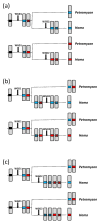Emergence of the Synucleins
- PMID: 37626939
- PMCID: PMC10451939
- DOI: 10.3390/biology12081053
Emergence of the Synucleins
Abstract
This study establishes the origin and evolutionary history of the synuclein genes. A combination of phylogenetic analyses of the synucleins from twenty-two model species, characterization of local synteny similarities among humans, sharks and lampreys, and statistical comparisons among lamprey and human chromosomes, provides conclusive evidence for the current diversity of synuclein genes arising from the whole-genome duplications (WGDs) that occurred in vertebrates. An ancestral synuclein gene was duplicated in a first WGD, predating the diversification of all living vertebrates. The two resulting genes are still present in agnathan vertebrates. The second WGD, specific to the gnathostome lineage, led to the emergence of the three classical synuclein genes, SNCA, SNCB and SNCG, which are present in all jawed vertebrate lineages. Additional WGDs have added new genes in both agnathans and gnathostomes, while some gene losses have occurred in particular species. The emergence of synucleins through WGDs prevented these genes from experiencing dosage effects, thus avoiding the potential detrimental effects associated with individual duplications of genes that encode proteins prone to aggregation. Additional insights into the structural and functional features of synucleins are gained through the analysis of the highly divergent synuclein proteins present in chondrichthyans and agnathans.
Keywords: Parkinson’s disease; agnathans; gnathostomes; synuclein; whole-genome duplication.
Conflict of interest statement
The author declares no conflict of interest.
Figures








Similar articles
-
Corticotropin-Releasing Hormone (CRH) Gene Family Duplications in Lampreys Correlate With Two Early Vertebrate Genome Doublings.Front Neurosci. 2020 Jul 30;14:672. doi: 10.3389/fnins.2020.00672. eCollection 2020. Front Neurosci. 2020. PMID: 32848532 Free PMC article.
-
Tumor Necrosis Factor Superfamily: Ancestral Functions and Remodeling in Early Vertebrate Evolution.Genome Biol Evol. 2020 Nov 3;12(11):2074-2092. doi: 10.1093/gbe/evaa140. Genome Biol Evol. 2020. PMID: 33210144 Free PMC article.
-
Hagfish genome elucidates vertebrate whole-genome duplication events and their evolutionary consequences.Nat Ecol Evol. 2024 Mar;8(3):519-535. doi: 10.1038/s41559-023-02299-z. Epub 2024 Jan 12. Nat Ecol Evol. 2024. PMID: 38216617 Free PMC article.
-
Reconstructing the ancestral vertebrate brain.Dev Growth Differ. 2017 May;59(4):163-174. doi: 10.1111/dgd.12347. Epub 2017 Apr 26. Dev Growth Differ. 2017. PMID: 28447337 Review.
-
Landmark discoveries in elucidating the origins of the hypothalamic-pituitary system from the perspective of a basal vertebrate, sea lamprey.Gen Comp Endocrinol. 2018 Aug 1;264:3-15. doi: 10.1016/j.ygcen.2017.10.016. Epub 2017 Oct 27. Gen Comp Endocrinol. 2018. PMID: 29111305 Review.
Cited by
-
Brain Region-Specific Expression Levels of Synuclein Genes in an Acid Sphingomyelinase Knockout Mouse Model: Correlation with Depression-/Anxiety-Like Behavior and Locomotor Activity in the Absence of Genotypic Variation.Int J Mol Sci. 2024 Aug 9;25(16):8685. doi: 10.3390/ijms25168685. Int J Mol Sci. 2024. PMID: 39201372 Free PMC article.
-
Vertebrate TNF Superfamily: Evolution and Functional Insights.Biology (Basel). 2025 Jan 10;14(1):54. doi: 10.3390/biology14010054. Biology (Basel). 2025. PMID: 39857285 Free PMC article.
References
LinkOut - more resources
Full Text Sources
Research Materials
Miscellaneous

